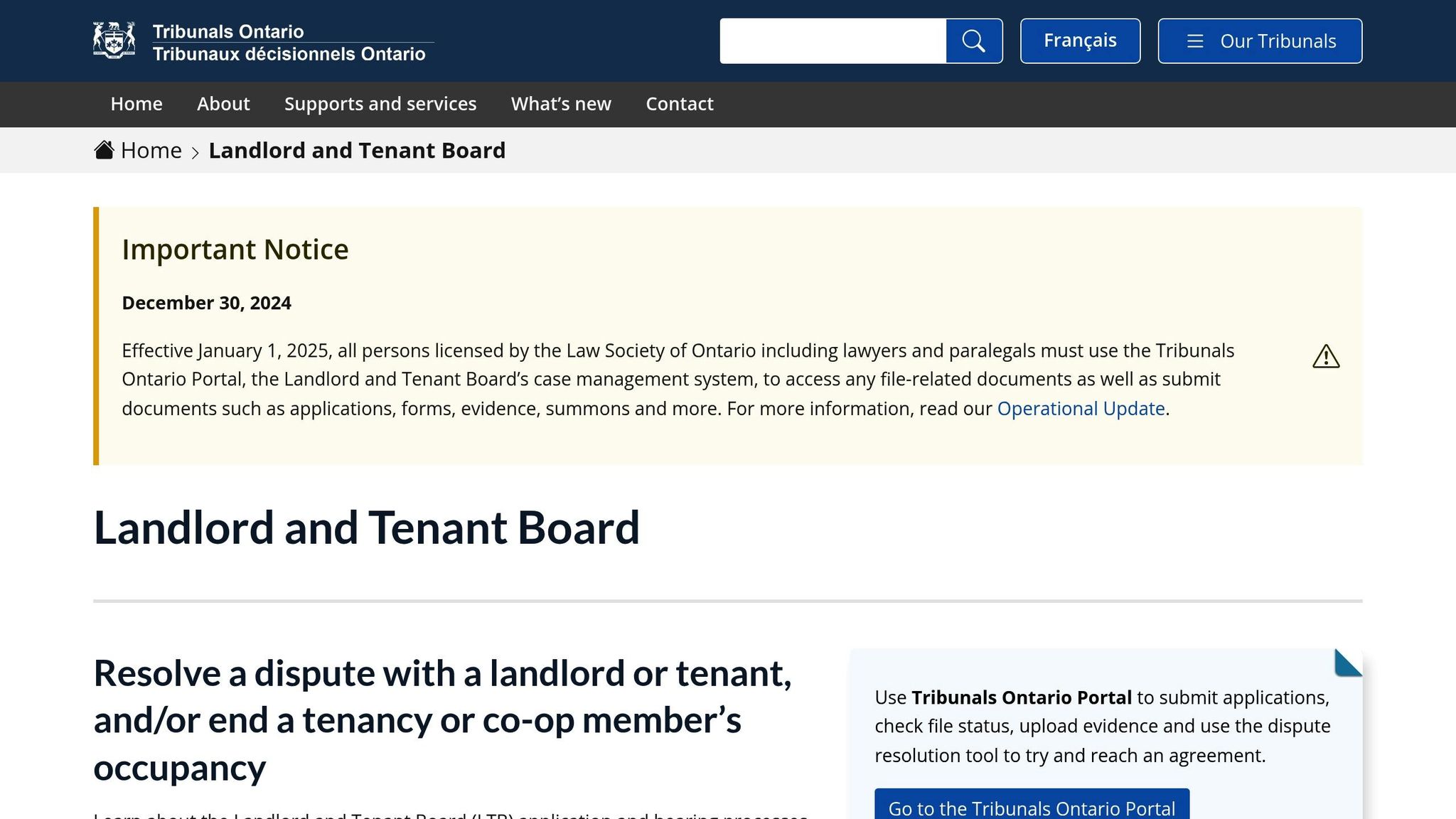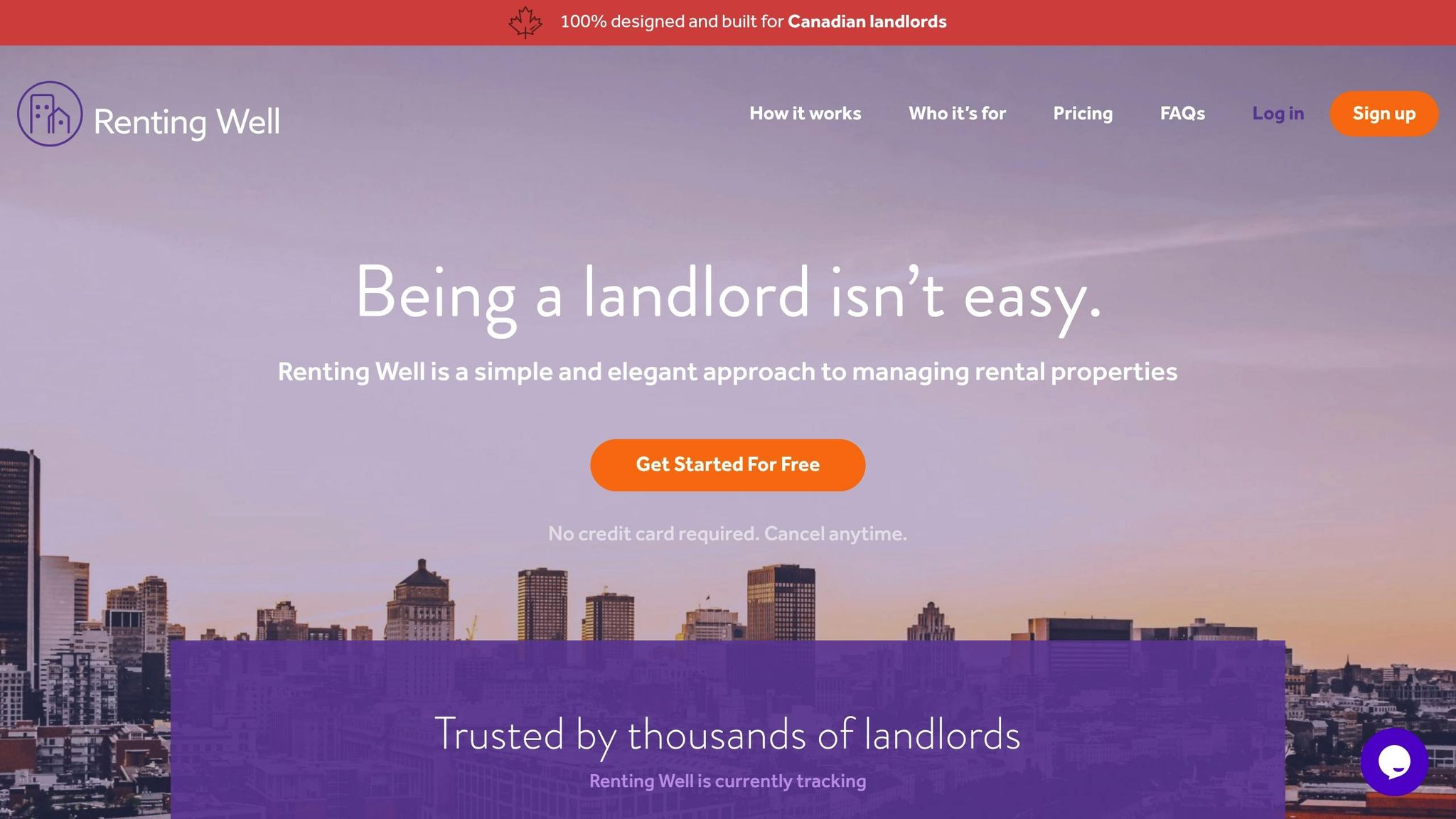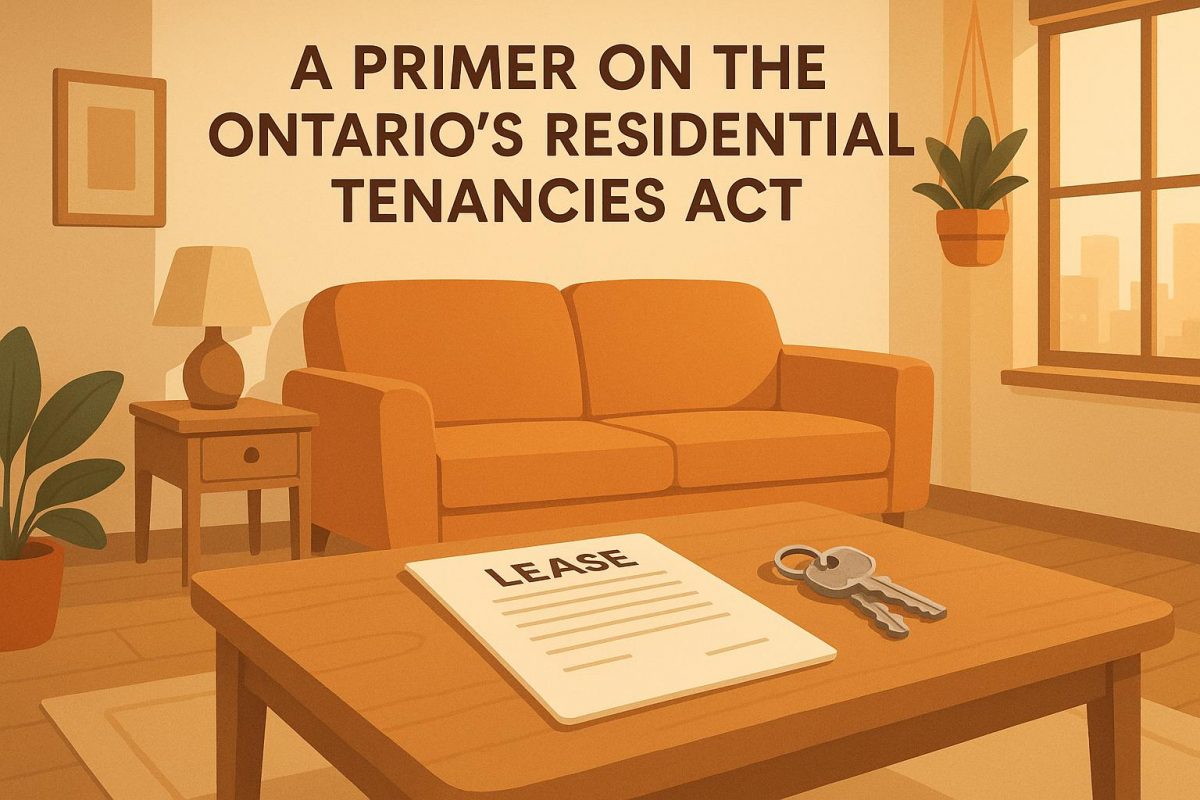The Residential Tenancies Act (RTA) governs rental relationships in Ontario, effective since January 31, 2007. It applies to most rental properties, including apartments, houses, and condos, but excludes situations where tenants share kitchens or bathrooms with the property owner. Here’s a quick breakdown of key points:
- Standard Lease: Mandatory for leases signed after April 30, 2018. Tenants must receive a copy within 21 days.
- Rent Rules: Rent increases allowed once every 12 months with 90 days’ notice. Properties built after November 15, 2018, may be exempt.
- Landlord Responsibilities: Maintain safety standards, provide essential services, and follow strict entry protocols (24-hour notice required for non-emergencies).
- Tenant Duties: Keep units clean, repair damages caused by themselves or guests, and follow property rules.
- Evictions: Require valid reasons and proper notice forms. Average eviction costs are about $11,500 and take 85-138 days.
- Dispute Resolution: The Landlord and Tenant Board (LTB) offers mediation or formal hearings for resolving conflicts.
For landlords, using property management software can simplify compliance by automating tasks like record-keeping, rent tracking, and maintenance logging. Staying organized and informed ensures smoother operations and adherence to the law.
Main Rules Under the RTA
Rights and Duties
The RTA outlines the responsibilities of both landlords and tenants. Landlords are required to keep rental properties in good condition while adhering to health and safety regulations.
Here are the main responsibilities for landlords:
- Property Maintenance: Ensure systems and appliances are functional, meet safety standards, and respond to repair needs promptly.
- Documentation and Communication: Keep accurate rental records and provide tenants with information about their rights.
- Service Continuity: Ensure access to essential utilities and maintain heating systems.
Tenants also have specific duties, such as:
- Keeping the rental unit clean.
- Repairing any damage they or their guests cause.
- Complying with the rules and regulations of the property.
These responsibilities create a foundation for resolving disputes through the Landlord and Tenant Board.
The Landlord and Tenant Board

The Landlord and Tenant Board (LTB) is the main body that handles disputes between landlords and tenants as laid out in the RTA.
"The Landlord and Tenant Board resolves disputes between tenants and landlords. Either a landlord or a tenant can apply to the LTB."
The LTB offers two ways to resolve disputes:
- Mediation: This voluntary process involves an LTB mediator helping both sides reach an agreement, often leading to faster resolutions.
- Formal Adjudication: If mediation doesn’t work or isn’t suitable, the LTB holds a formal hearing. Both sides present evidence, and an LTB member makes a binding decision.
Leases and Rent Rules
Required Lease Terms
Since April 30, 2018, Ontario has required landlords and tenants to use a standard lease form. This form was updated on March 1, 2021, to ensure rental agreements meet specific legal requirements for both parties.
Key elements of the lease include:
- Names of all parties, details of the rental unit, and contact information
- Total rent amount, payment methods, and due dates
- Responsibilities for utilities
- Policies on smoking and insurance requirements
- Obligations for repairs and maintenance
"In order to protect tenants from landlords looking to take advantage of them, the province puts a limit on how rapidly rent can be increased, and when." – Corben Grant, CREW
These lease terms align with the rent rules outlined in the next section.
Rent Rules
Ontario law imposes strict guidelines on rent increases. Landlords are allowed to increase rent only once every 12 months, and tenants must receive at least 90 days’ notice using the official form.
| Aspect | Requirement |
|---|---|
| Frequency | Once every 12 months |
| Notice Period | Minimum of 90 days |
| Standard Increase (2022) | 1.2% maximum |
| Previous Year (2020) | 2.2% maximum |
| Exempt Properties | Units built or first occupied after November 15, 2018 |
If landlords wish to raise rent beyond the guideline, they must get approval from the Landlord and Tenant Board (LTB) by proving exceptional circumstances, such as significant property upgrades or higher operating costs.
In addition to rent rules, the law also regulates how leases can be transferred.
Lease Changes and Transfers
The Act provides clear rules for lease transfers. Tenants must seek the landlord’s approval for any transfer, and landlords can only refuse for valid reasons.
- Assignments: A new tenant fully takes over the lease terms.
- Sublets: The original tenant temporarily moves out but remains responsible for the unit.
- Restrictions: Some tenants, like superintendents or those in specific housing arrangements, may not have the right to transfer their leases.
Evictions and Disputes
Eviction Steps and Requirements
In Ontario, landlords must follow a strict process outlined in the Residential Tenancies Act to evict tenants. On average, evictions take between 85 and 138 days and cost around $11,500. This includes approximately $2,600 in direct fees and $9,000 in lost rent.
Landlords need to use the correct notice form based on the reason for eviction:
| Eviction Reason | Required Form | Notice Period |
|---|---|---|
| Non-payment of rent | N4 Notice | 14 days (monthly tenants) 7 days (weekly tenants) |
| Persistent late payment | N8 Notice | 60 days (monthly tenants) 28 days (weekly tenants) |
| Property damage/interference | N5 Notice | 20 days (first notice) 14 days (second notice) |
| Serious problems/illegal acts | N7/N6 Notice | At least 10 days |
If tenants do not comply with the notice, landlords must submit an application to the Landlord and Tenant Board (LTB) and pay a $186 filing fee. Once filed, the average processing time is 77.7 days.
"Yes. You most certainly can evict a Tenant in Ontario, but you must have a valid reason to do so. The Residential Tenancies Act sets out the legal reasons to evict your Tenant in Ontario." – Sturino Walker Legal Services
If the tenant challenges the eviction, the dispute resolution process begins immediately.
Solving Disputes
The LTB handles disputes through mediation, which is quicker and less expensive than formal hearings. If mediation fails, a formal hearing is the next step. A recent case highlighted the importance of proper documentation and following LTB procedures for a successful resolution.
Money-Saving Tip: Offering a "cash for keys" agreement can help avoid the lengthy and costly eviction process. While it involves upfront payment, it is often cheaper than the average $11,500 cost of formal eviction.
Only the Sheriff’s Office is authorized to enforce eviction orders.
sbb-itb-9e51f47
Software Tools for RTA Compliance
Digital Property Management
Using modern property management software can make staying compliant with RTA requirements much easier. These tools help automate routine tasks and reduce the chances of non-compliance.
With property management platforms, landlords can:
- Store important documents: Keep leases, notices, and maintenance records organized digitally.
- Track repairs: Log repair requests, schedule maintenance, and document completion dates.
- Generate rent receipts: Automatically track and store payment histories.
- Archive communications: Save tenant messages and maintenance requests with timestamps.
Having a reliable digital system ensures landlords have the documentation they need for RTA compliance. This can be especially helpful during disputes.
Renting Well Features

Renting Well takes these digital tools a step further with features designed to simplify RTA compliance:
| Feature | Compliance Benefit |
|---|---|
| Document Storage | Keeps leases, notices, and required forms secure and accessible. |
| Financial Tracking | Automatically generates rent receipts and maintains payment records. |
| Maintenance Logger | Tracks repair requests and their completion dates. |
| Tenant Portal | Provides an easy way to send and store written notices and communications. |
| Unit Management | Monitors unit conditions and ensures maintenance standards are met. |
This cloud-based platform offers access to key records anytime, while automating tasks like financial tracking. It’s particularly useful for preparing for hearings or ensuring rent payment guidelines are met.
For landlords managing multiple units, the software’s batch processing feature allows them to create required documents for several units at once, saving time and keeping compliance consistent.
Conclusion
Key Points Review
The Ontario Residential Tenancies Act (RTA) outlines essential rules for landlord-tenant relationships, including:
- Standardized leases for agreements made after April 30, 2018.
- Rent deposits capped at one month’s rent, with annual interest required.
- 90-day notice for rent increases and 24-hour notice for unit entry.
- Properties must meet established health, safety, and maintenance standards.
These guidelines, enforced by the Landlord and Tenant Board, form the backbone of the RTA’s provisions.
Landlords can start by focusing on these key areas to ensure compliance and smooth operations.
Action Steps
- Simplify Compliance
- Use tools like Renting Well’s platform to manage documents, track maintenance, and automate reminders.
- Align all communications and records with RTA requirements.
- Stay on top of deadlines for notices, inspections, and maintenance tasks.
- Automate Key Processes
- Automatically generate rent receipts.
- Schedule and log property inspections.
- Track maintenance requests and their resolution times.
- Keep tenant communications organized and accessible.
- Digitize Records
- Save lease agreements, notices, and maintenance logs in one place.
- Maintain records of rent payments and increase notices.
- Store inspection reports and communication histories.
- Build an audit trail to safeguard against potential disputes.
The Residential Tenancies Act
FAQs
What are the rent increase exemptions under Ontario’s Residential Tenancies Act, and how can landlords qualify?
Certain rental units in Ontario are exempt from the standard rent control rules under the Residential Tenancies Act. For example, properties first occupied after November 15, 2018, such as newly built apartments, basement units, or additions to existing buildings, may qualify for these exemptions. This allows landlords to increase rent without following the usual annual guidelines.
Even for exempt units, landlords must provide tenants with at least 90 days’ written notice before increasing rent and can only do so once every 12 months. To confirm eligibility for these exemptions, landlords may need to present documentation like building permits or occupancy records. Ensuring proper compliance can help avoid potential disputes with tenants.
What is the Landlord and Tenant Board’s mediation process, and why is it a good alternative to a formal hearing?
The Landlord and Tenant Board (LTB) offers a mediation service to help landlords and tenants resolve disputes in a cooperative way. Mediation is facilitated by a neutral mediator who helps both parties discuss their issues and work toward a mutually acceptable agreement. Unlike a formal hearing, the mediator does not make decisions but supports the negotiation process.
Mediation is voluntary, meaning both the landlord and tenant must agree to participate. If an agreement is reached, it is documented in writing, and the need for a hearing is eliminated. If mediation is unsuccessful, the case will proceed to a formal hearing. Mediation can often lead to faster resolutions, reduce stress, and provide more flexibility compared to a formal adjudication process. It can be requested ahead of a hearing or even on the day of the hearing, making it a convenient and efficient option for resolving disputes.
What should landlords do to comply with Ontario’s Residential Tenancies Act when managing multiple rental properties?
To stay compliant with Ontario’s Residential Tenancies Act (RTA) while managing multiple rental properties, landlords should focus on key responsibilities outlined in the Act. This includes ensuring all tenancy agreements are in writing, clearly outlining the terms of the lease, and providing tenants with the required information, such as a copy of the lease and details about their rights and responsibilities.
Landlords must also follow the rules for rent increases, provide proper notice for any changes or terminations, and respect tenants’ rights to quiet enjoyment of their rental units. Familiarizing yourself with the Landlord and Tenant Board processes for resolving disputes or handling evictions is essential for navigating legal challenges effectively.
By staying informed and organized, landlords can manage their properties in compliance with the RTA while fostering positive relationships with tenants.
